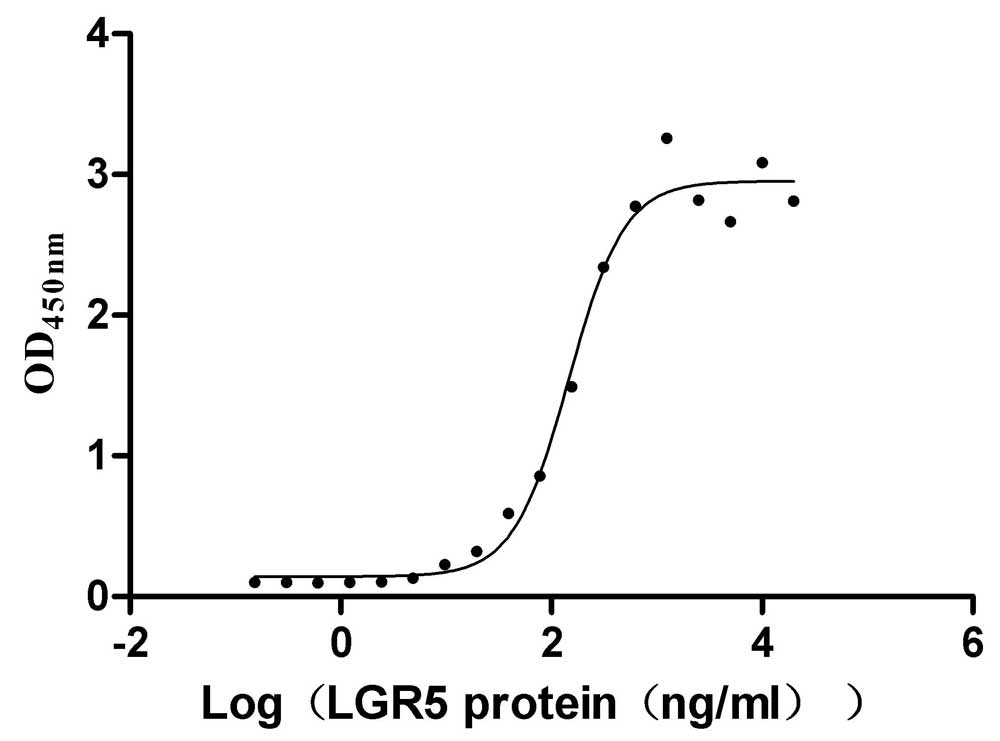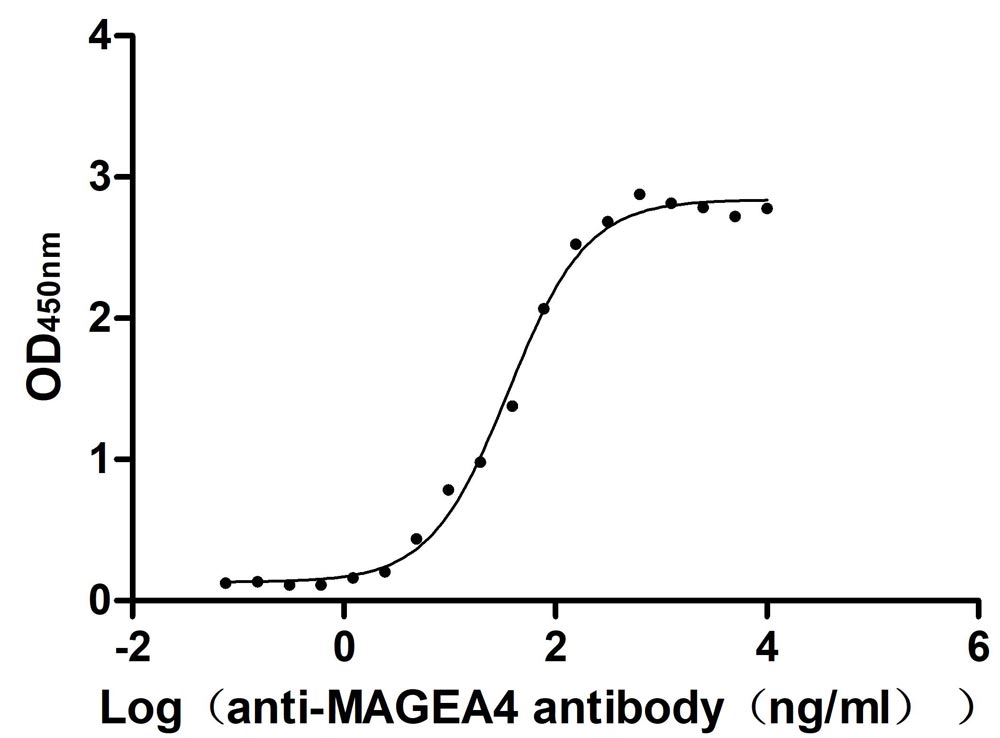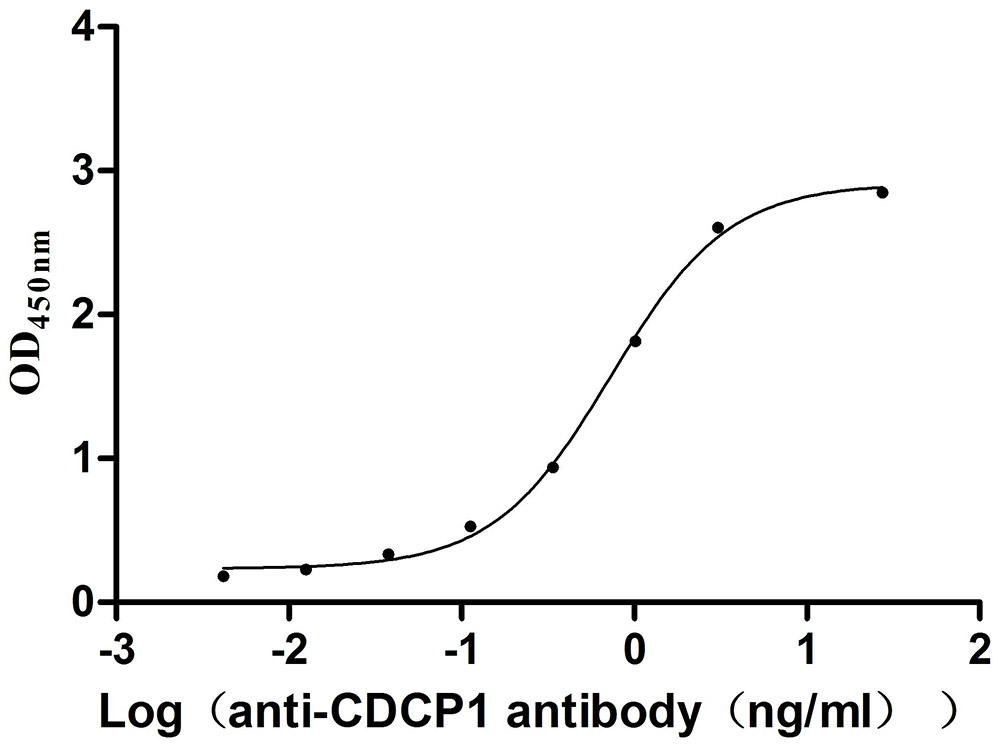Recombinant Human SARS coronavirus Nucleoprotein (N)
-
中文名称:Recombinant Human SARS coronavirus Nucleoprotein(N),Yeast
-
货号:CSB-YP349523HQE
-
规格:
-
来源:Yeast
-
其他:
-
中文名称:Recombinant Human SARS coronavirus Nucleoprotein(N),Yeast
-
货号:CSB-EP349523HQE-B
-
规格:
-
来源:E.coli
-
共轭:Avi-tag Biotinylated
E. coli biotin ligase (BirA) is highly specific in covalently attaching biotin to the 15 amino acid AviTag peptide. This recombinant protein was biotinylated in vivo by AviTag-BirA technology, which method is BriA catalyzes amide linkage between the biotin and the specific lysine of the AviTag.
-
其他:
-
中文名称:Recombinant Human SARS coronavirus Nucleoprotein(N),Yeast
-
货号:CSB-MP349523HQE
-
规格:
-
来源:Mammalian cell
-
其他:
产品详情
-
纯度:>85% (SDS-PAGE)
-
基因名:
-
Uniprot No.:
-
别名:N; 9aNucleoprotein; Nucleocapsid protein; NC; Protein N
-
种属:Human SARS coronavirus (SARS-CoV) (Severe acute respiratory syndrome coronavirus)
-
蛋白长度:full length protein
-
表达区域:1-422
-
氨基酸序列MSDNGPQSNQ RSAPRITFGG PTDSTDNNQN GGRNGARPKQ RRPQGLPNNT ASWFTALTQH GKEELRFPRG QGVPINTNSG PDDQIGYYRR ATRRVRGGDG KMKELSPRWY FYYLGTGPEA SLPYGANKEG IVWVATEGAL NTPKDHIGTR NPNNNAATVL QLPQGTTLPK GFYAEGSRGG SQASSRSSSR SRGNSRNSTP GSSRGNSPAR MASGGGETAL ALLLLDRLNQ LESKVSGKGQ QQQGQTVTKK SAAEASKKPR QKRTATKQYN VTQAFGRRGP EQTQGNFGDQ DLIRQGTDYK HWPQIAQFAP SASAFFGMSR IGMEVTPSGT WLTYHGAIKL DDKDPQFKDN VILLNKHIDA YKTFPPTEPK KDKKKKTDEA QPLPQRQKKQ PTVTLLPAAD MDDFSRQLQN SMSGASADST QA
-
蛋白标签:Tag type will be determined during the manufacturing process.
The tag type will be determined during production process. If you have specified tag type, please tell us and we will develop the specified tag preferentially. -
产品提供形式:Lyophilized powder
Note: We will preferentially ship the format that we have in stock, however, if you have any special requirement for the format, please remark your requirement when placing the order, we will prepare according to your demand. -
复溶:We recommend that this vial be briefly centrifuged prior to opening to bring the contents to the bottom. Please reconstitute protein in deionized sterile water to a concentration of 0.1-1.0 mg/mL.We recommend to add 5-50% of glycerol (final concentration) and aliquot for long-term storage at -20℃/-80℃. Our default final concentration of glycerol is 50%. Customers could use it as reference.
-
储存条件:Store at -20°C/-80°C upon receipt, aliquoting is necessary for mutiple use. Avoid repeated freeze-thaw cycles.
-
保质期:The shelf life is related to many factors, storage state, buffer ingredients, storage temperature and the stability of the protein itself.
Generally, the shelf life of liquid form is 6 months at -20°C/-80°C. The shelf life of lyophilized form is 12 months at -20°C/-80°C. -
货期:Delivery time may differ from different purchasing way or location, please kindly consult your local distributors for specific delivery time.Note: All of our proteins are default shipped with normal blue ice packs, if you request to ship with dry ice, please communicate with us in advance and extra fees will be charged.
-
注意事项:Repeated freezing and thawing is not recommended. Store working aliquots at 4°C for up to one week.
-
Datasheet :Please contact us to get it.
相关产品
靶点详情
-
功能:Packages the positive strand viral genome RNA into a helical ribonucleocapsid (RNP) and plays a fundamental role during virion assembly through its interactions with the viral genome and membrane protein M. Plays an important role in enhancing the efficiency of subgenomic viral RNA transcription as well as viral replication. May modulate transforming growth factor-beta signaling by binding host SMAD3.
-
基因功能参考文献:
- The severe acute respiratory syndrome coronavirus N protein was found to bind to the SPRY domain of the tripartite motif protein 25 (TRIM25) E3 ubiquitin ligase, thereby interfering with the association between TRIM25 and retinoic acid-inducible gene I (RIG-I) and inhibiting TRIM25-mediated RIG-I ubiquitination and activation. PMID: 28148787
- Electrostatic repulsion acts as a switch to regulate SARS virus N protein oligomerization. PMID: 23717688
- These results suggest that SARS coronavirus could reduce pyruvate kinase activity via its nucleocapsid protein, and this may in turn cause disease. PMID: 22222284
- The co-localization of SARS-CoVN and CXCL16 in the cytoplasm of HEK293FT cells was also shown using confocal laser scanning microscopy. PMID: 20960183
- The HLA-A 2402 complexed with SARSV N1 showed a novel host strategy to present an immunodominant CTL epitope by intrachain hydrogen bond as a featured epitope. PMID: 20844028
- SARS-CoV N interacts with MAP19 and increased the expression of MAP19 in cells. PMID: 19737459
- This is the first report showing the ability of the nucleocapsid protein of SARS-CoV to induce apoptosis and actin reorganization in mammalian cells under stressed conditions. PMID: 15294014
- analysis of SARS-CoV nucleocapsid protein expressed in insect cells PMID: 15514849
- The nucleocapsid protein of the SARS coronavirus was cloned and purified. PMID: 15523835
- Binding to cyclophilin A during invasion of host cells. PMID: 15688292
- coronavirus N protein undergoes posttranslational modification by sumoylation; functional implication of this modification in the formation of coronavirus ribouncleoprotein complex, virion assembly and virus-host interactions PMID: 15848177
- the nucleocapsid protein forms a dimer through its C-terminal domain PMID: 15849181
- Differences in nuclear/nucleolar localization properties of N from other members of coronavirus family suggest a unique shuttle protein function for N, which may play an important role in the pathogenesis of SARS. PMID: 15992957
- results showed that the SARS-CoV N protein can significantly activate NF-kappaB only in Vero E6 cells, which are susceptible to SARS-CoV infection, but not in Vero or HeLa cells; suggests that NF-kappaB activation is cell-specific PMID: 16143815
- The secondary structure of the dimerization domain consists of five alpha helices and a beta-hairpin. PMID: 16214138
- Results show that the N protein consists of two non-interacting structural domains, the N-terminal RNA-binding domain (RBD) (residues 45-181) and the C-terminal dimerization domain (residues 248-365) (DD), surrounded by flexible linkers. PMID: 16228284
- data suggest that the SR-rich motif of the SARS-CoV N protein might play an import role in the transformation of the SARS-CoV N protein between the dimer and multimer during its binding to its central region for self-association or dissociation PMID: 16285739
- cytoplasmic localization was directed by region III and was the dominant localization signal in the N protein. PMID: 16298975
- the S phase inhibitory activity of the N protein may have major significance during viral pathogenesis PMID: 16431923
- the N protein has a dimer with extensive interactions between the two subunits, suggesting that the dimeric form of the N protein is the functional unit in vivo PMID: 16627473
- using the solution structure of severe acute respiratory (SARS) coronavirus N-protein, revealed that this motif is available for interaction with cellular factors which may mediate nucleolar localization PMID: 16734668
- This is the first report demonstrating the interaction of hUbc9 with a structural protein of plus-strand RNA viruses, indicating a new drug target for SARS-CoV. PMID: 16998888
- the nucleocapsid protein of severe acute respiratory syndrome coronavirus is sumoylated by interaction with Ubc9 PMID: 17037517
- characterization of the structures of N protein N-terminal domain in two crystal forms, at 1.17 A (monoclinic) and at 1.85 A (cubic), respectively PMID: 17229691
- The C-terminal domain (CTD), spanning residues 248-365 (NP248-365), had stronger nucleic acid-binding activity than the NTD. The crystal structure of the NP248-365 region is solved, suggesting a mechanism for helical RNA packaging in the virus. PMID: 17379242
- SARS coronavirus N protein can induce apoptosis of COS-1 cells by activating mitochondrial pathway PMID: 17453707
- We also showed that N protein activated IL-6 expression through NF-kappaB by facilitating the translocation of NF-kappaB from cytosol to nucleus. PMID: 17490702
- SARS coronavirus nucleocapsid protein interacts with Smad3 and modulates transforming growth factor-beta signaling PMID: 18055455
- The experiments revealed that N induces the intrinsic apoptotic pathway, resulting in processing of N at residues 400 and 403 by caspase-6 and/or caspase-3. PMID: 18155731
- fgl2 gene transcription induced by the N protein of SARS-CoV was dependent on transcription factor C/EBP alpha binding with its cognate cis-element in fgl2 promoter. PMID: 18390877
- It was demonstrated that the N protein of SARS-CoV induces aggregation of EF1, inhibiting protein translation and cytokinesis by blocking F-actin bundling. PMID: 18448518
- This study employed the SAIL method to determine the high-quality solution structure of the severe acute respiratory syndrome coronavirus nucleocapsid protein C-terminal domain by NMR. PMID: 18561946
- the domain conferring the ability to direct virus-like particle assembly and release in SARS-CoV N is largely contained between residues 168 and 421 PMID: 18592403
- Phosphorylation of the arginine/serine motif of the nucleocapsid protein did not significantly affect RNA binding of the nucleocapsid protein but impaired its multimerization ability. PMID: 18631359
- This paper describes the work to identify two proteins/protein fragments of N protein and to determine their source. PMID: 18926799
- An excessive host immune response against the nucleocapsid protein of severe acute respiratory syndrome-associated coronavirus (SARS-CoV) is involved in severe pneumonia caused by SARS-CoV infection. PMID: 18941225
- The SARS-CoV N protein is a modular protein containing multiple RNA-binding sites. PMID: 19052082
- thermostability of the N-terminal RNA-binding domain (RBD) of the N protein; results showed the thermal-induced unfolding-folding transition of the RBD follows a two-state model with a reversibility >90% PMID: 19254548
- SR-rich motif is critical for effective virus replication. PMID: 19370068
- SARS-CoV N protein specifically modulates transcription of the FGL2 gene to cause fibrosis and vascular thrombosis. PMID: 19423547
显示更多
收起更多
-
亚细胞定位:Virion. Host endoplasmic reticulum-Golgi intermediate compartment. Host Golgi apparatus. Host cytoplasm, host perinuclear region.
-
蛋白家族:Betacoronavirus nucleocapsid protein family
-
数据库链接:
KEGG: vg:1489678
Most popular with customers
-
Recombinant Macaca mulatta Microtubule-associated protein tau (MAPT) (Active)
Express system: Mammalian cell
Species: Macaca mulatta (Rhesus macaque)
-
Recombinant Human R-spondin-1 (RSPO1), partial (Active)
Express system: Mammalian cell
Species: Homo sapiens (Human)
-
Recombinant Human Melanoma-associated antigen 4 (MAGEA4) (Active)
Express system: Mammalian cell
Species: Homo sapiens (Human)
-
Recombinant Macaca fascicularis Trophoblast glycoprotein (TPBG), partial (Active)
Express system: Mammalian cell
Species: Macaca fascicularis (Crab-eating macaque) (Cynomolgus monkey)
-
Recombinant Human Trophoblast glycoprotein (TPBG), partial (Active)
Express system: Mammalian cell
Species: Homo sapiens (Human)
-
Recombinant Human Claudin-6 (CLDN6)-VLPs, Fluorescent (Active)
Express system: Mammalian cell
Species: Homo sapiens (Human)
-
Recombinant Human Glucagon-like peptide 1 receptor (GLP1R), partial (Active)
Express system: Mammalian cell
Species: Homo sapiens (Human)
-
Recombinant Mouse CUB domain-containing protein 1 (Cdcp1), partial (Active)
Express system: Mammalian cell
Species: Mus musculus (Mouse)







f4-AC1.jpg)












